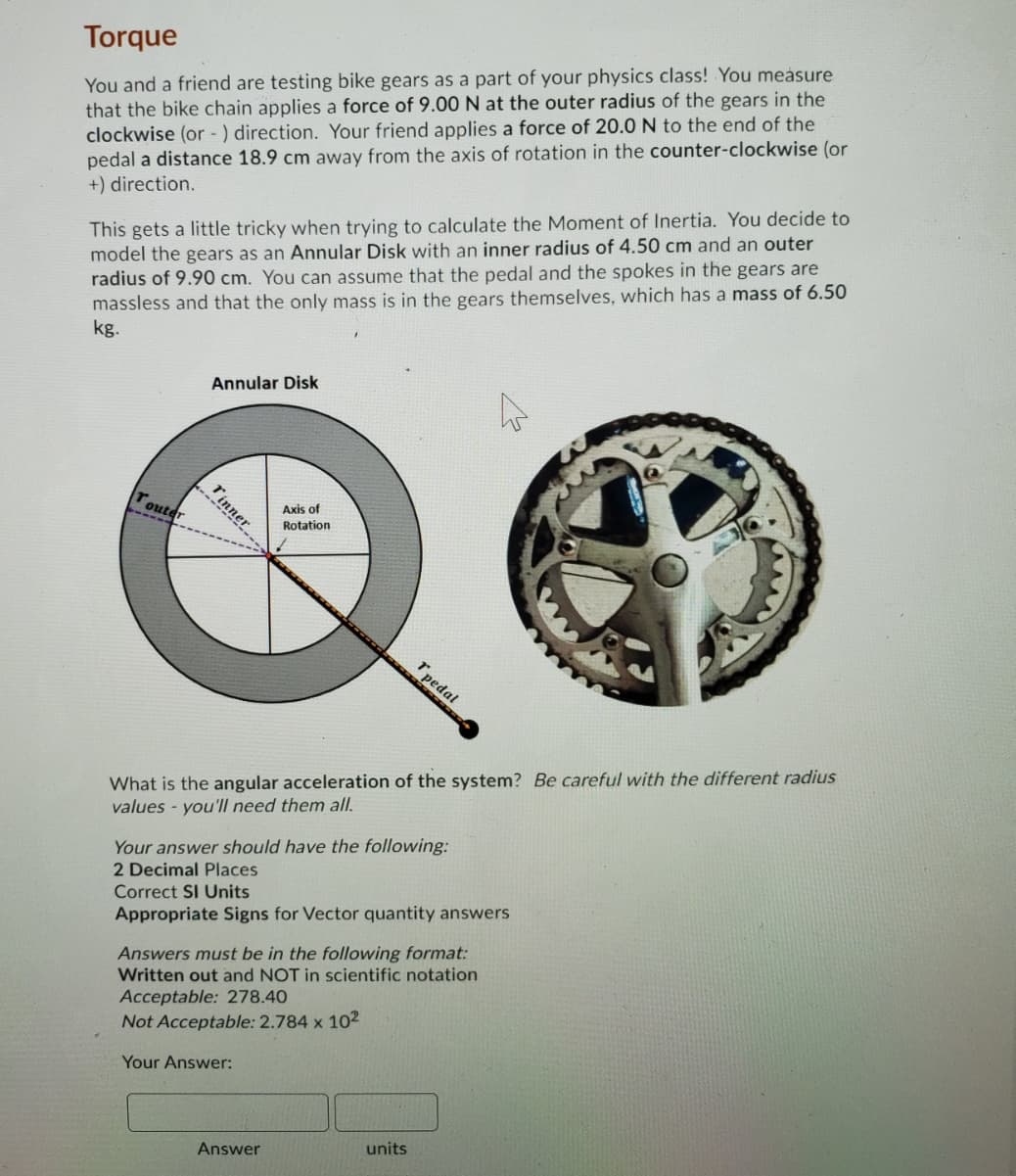You and a friend are testing bike gears as a part of your physics class! You measure that the bike chain applies a force of 9.00 N at the outer radius of the gears in the clockwise (or ) direction. Your friend applies a force of 20.0 N to the end of the pedal a distance 18.9 cm away from the axis of rotation in the counter-clockwise (or +) direction. This gets a little tricky when trying to calculate the Moment of Inertia. You decide to model the gears as an Annular Disk with an inner radius of 4.50 cm and an outer radius of 9.90 cm. You can assume that the pedal and the spokes in the gears are massless and that the only mass is in the gears themselves, which has a mass of 6.50 kg.
You and a friend are testing bike gears as a part of your physics class! You measure that the bike chain applies a force of 9.00 N at the outer radius of the gears in the clockwise (or ) direction. Your friend applies a force of 20.0 N to the end of the pedal a distance 18.9 cm away from the axis of rotation in the counter-clockwise (or +) direction. This gets a little tricky when trying to calculate the Moment of Inertia. You decide to model the gears as an Annular Disk with an inner radius of 4.50 cm and an outer radius of 9.90 cm. You can assume that the pedal and the spokes in the gears are massless and that the only mass is in the gears themselves, which has a mass of 6.50 kg.
Glencoe Physics: Principles and Problems, Student Edition
1st Edition
ISBN:9780078807213
Author:Paul W. Zitzewitz
Publisher:Paul W. Zitzewitz
Chapter8: Rotational Motion
Section8.2: Rotational Dynamics
Problem 28PP
Related questions
Question

Transcribed Image Text:Torque
You and a friend are testing bike gears as a part of your physics class! You measure
that the bike chain applies a force of 9.00 N at the outer radius of the gears in the
clockwise (or - ) direction. Your friend applies a force of 20.0 N to the end of the
pedal a distance 18.9 cm away from the axis of rotation in the counter-clockwise (or
+) direction.
This gets a little tricky when trying to calculate the Moment of Inertia. You decide to
model the gears as an Annular Disk with an inner radius of 4.50 cm and an outer
radius of 9.90 cm. You can assume that the pedal and the spokes in the gears are
massless and that the only mass is in the gears themselves, which has a mass of 6.50
kg.
Annular Disk
outer
Axis of
Rotation
Ipedal
What is the angular acceleration of the system? Be careful with the different radius
values - you'll need them all.
Your answer should have the following:
2 Decimal Places
Correct SI Units
Appropriate Signs for Vector quantity answers
Answers must be in the following format:
Written out and NOT in scientific notation
Acceptable: 278.40
Not Acceptable: 2.784 x 102
Your Answer:
Answer
units
Tinner
Expert Solution
This question has been solved!
Explore an expertly crafted, step-by-step solution for a thorough understanding of key concepts.
This is a popular solution!
Trending now
This is a popular solution!
Step by step
Solved in 2 steps

Knowledge Booster
Learn more about
Need a deep-dive on the concept behind this application? Look no further. Learn more about this topic, physics and related others by exploring similar questions and additional content below.Recommended textbooks for you

Glencoe Physics: Principles and Problems, Student…
Physics
ISBN:
9780078807213
Author:
Paul W. Zitzewitz
Publisher:
Glencoe/McGraw-Hill

University Physics Volume 1
Physics
ISBN:
9781938168277
Author:
William Moebs, Samuel J. Ling, Jeff Sanny
Publisher:
OpenStax - Rice University

Glencoe Physics: Principles and Problems, Student…
Physics
ISBN:
9780078807213
Author:
Paul W. Zitzewitz
Publisher:
Glencoe/McGraw-Hill

University Physics Volume 1
Physics
ISBN:
9781938168277
Author:
William Moebs, Samuel J. Ling, Jeff Sanny
Publisher:
OpenStax - Rice University